Statistical Analysis of Neural Differentiation of iPSCs Experiment
VerifiedAdded on 2023/05/28
|8
|1259
|484
Report
AI Summary
This report presents a statistical analysis of an experiment on the neural differentiation of induced pluripotent stem cells (iPSCs). The experiment investigated the effects of compounds X, Y, and Z on iPSCs derived from six donors, measuring neural differentiation using qRT-PCR analysis of SOX1 expression and loss of pluripotency via NANOG expression. The report includes summary statistics generated using Microsoft Excel, ANOVA tests, and t-tests to evaluate the significance of differences between treatment groups. The results indicate that while the means for X, Y, and Z treatments in SOXI are statistically similar according the ANOVA results, the means for X, Y, and Z treatments in SOXI are not similar according the ANOVA results. The report also includes graphical representations of the data and concludes with recommendations for future studies, suggesting continued evaluation of SOX1 expression and reevaluation of the NANOG expression measurement technique, particularly for treatment X.
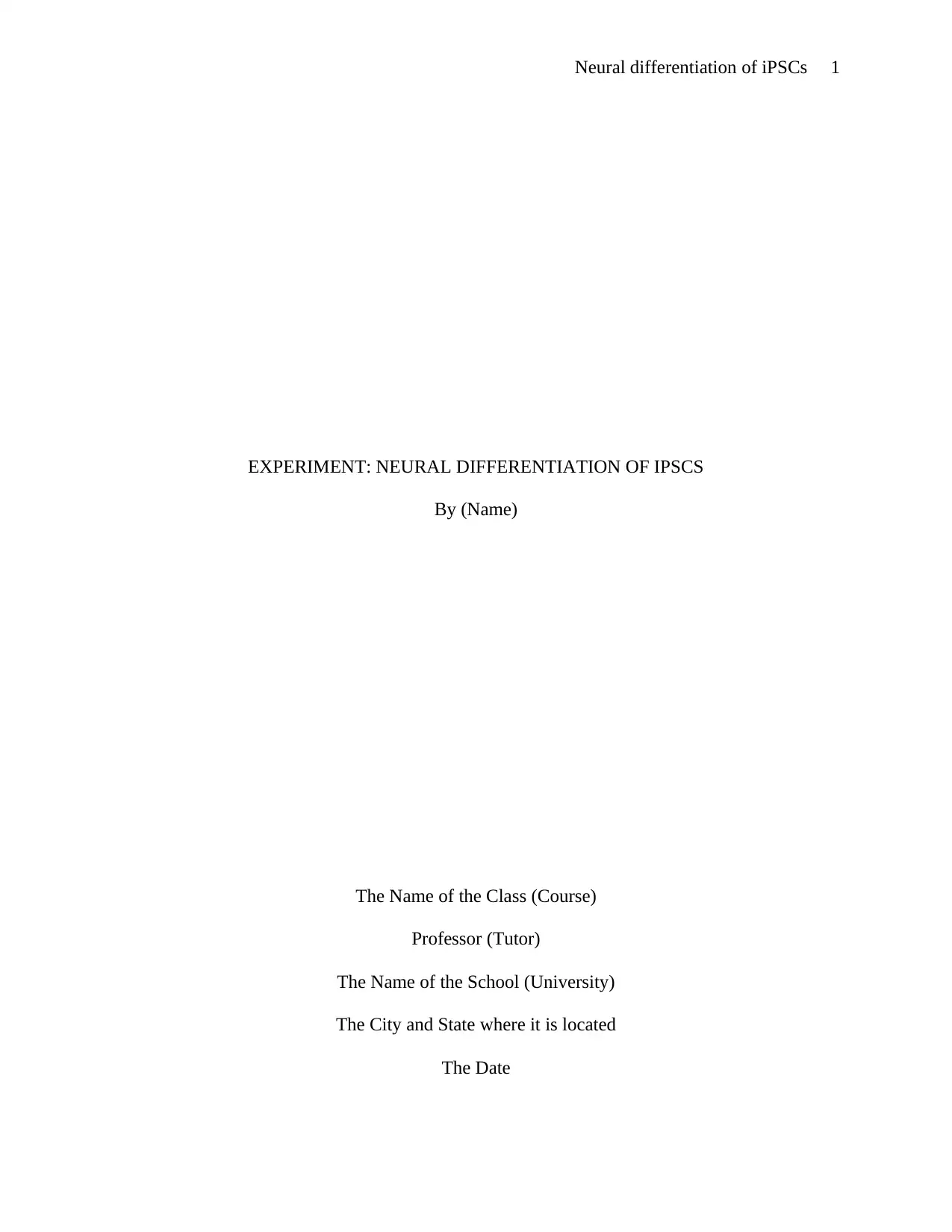
Neural differentiation of iPSCs 1
EXPERIMENT: NEURAL DIFFERENTIATION OF IPSCS
By (Name)
The Name of the Class (Course)
Professor (Tutor)
The Name of the School (University)
The City and State where it is located
The Date
EXPERIMENT: NEURAL DIFFERENTIATION OF IPSCS
By (Name)
The Name of the Class (Course)
Professor (Tutor)
The Name of the School (University)
The City and State where it is located
The Date
Paraphrase This Document
Need a fresh take? Get an instant paraphrase of this document with our AI Paraphraser
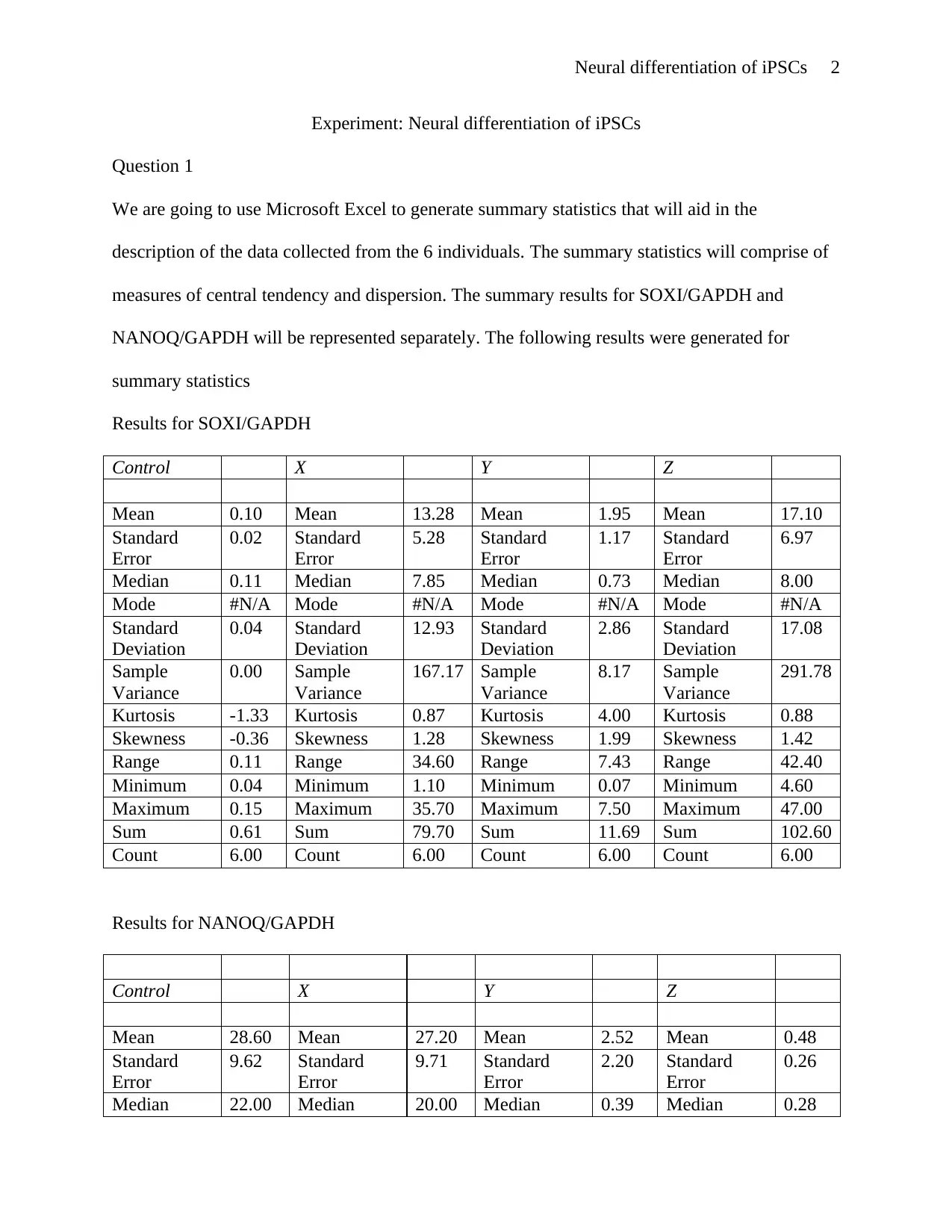
Neural differentiation of iPSCs 2
Experiment: Neural differentiation of iPSCs
Question 1
We are going to use Microsoft Excel to generate summary statistics that will aid in the
description of the data collected from the 6 individuals. The summary statistics will comprise of
measures of central tendency and dispersion. The summary results for SOXI/GAPDH and
NANOQ/GAPDH will be represented separately. The following results were generated for
summary statistics
Results for SOXI/GAPDH
Control X Y Z
Mean 0.10 Mean 13.28 Mean 1.95 Mean 17.10
Standard
Error
0.02 Standard
Error
5.28 Standard
Error
1.17 Standard
Error
6.97
Median 0.11 Median 7.85 Median 0.73 Median 8.00
Mode #N/A Mode #N/A Mode #N/A Mode #N/A
Standard
Deviation
0.04 Standard
Deviation
12.93 Standard
Deviation
2.86 Standard
Deviation
17.08
Sample
Variance
0.00 Sample
Variance
167.17 Sample
Variance
8.17 Sample
Variance
291.78
Kurtosis -1.33 Kurtosis 0.87 Kurtosis 4.00 Kurtosis 0.88
Skewness -0.36 Skewness 1.28 Skewness 1.99 Skewness 1.42
Range 0.11 Range 34.60 Range 7.43 Range 42.40
Minimum 0.04 Minimum 1.10 Minimum 0.07 Minimum 4.60
Maximum 0.15 Maximum 35.70 Maximum 7.50 Maximum 47.00
Sum 0.61 Sum 79.70 Sum 11.69 Sum 102.60
Count 6.00 Count 6.00 Count 6.00 Count 6.00
Results for NANOQ/GAPDH
Control X Y Z
Mean 28.60 Mean 27.20 Mean 2.52 Mean 0.48
Standard
Error
9.62 Standard
Error
9.71 Standard
Error
2.20 Standard
Error
0.26
Median 22.00 Median 20.00 Median 0.39 Median 0.28
Experiment: Neural differentiation of iPSCs
Question 1
We are going to use Microsoft Excel to generate summary statistics that will aid in the
description of the data collected from the 6 individuals. The summary statistics will comprise of
measures of central tendency and dispersion. The summary results for SOXI/GAPDH and
NANOQ/GAPDH will be represented separately. The following results were generated for
summary statistics
Results for SOXI/GAPDH
Control X Y Z
Mean 0.10 Mean 13.28 Mean 1.95 Mean 17.10
Standard
Error
0.02 Standard
Error
5.28 Standard
Error
1.17 Standard
Error
6.97
Median 0.11 Median 7.85 Median 0.73 Median 8.00
Mode #N/A Mode #N/A Mode #N/A Mode #N/A
Standard
Deviation
0.04 Standard
Deviation
12.93 Standard
Deviation
2.86 Standard
Deviation
17.08
Sample
Variance
0.00 Sample
Variance
167.17 Sample
Variance
8.17 Sample
Variance
291.78
Kurtosis -1.33 Kurtosis 0.87 Kurtosis 4.00 Kurtosis 0.88
Skewness -0.36 Skewness 1.28 Skewness 1.99 Skewness 1.42
Range 0.11 Range 34.60 Range 7.43 Range 42.40
Minimum 0.04 Minimum 1.10 Minimum 0.07 Minimum 4.60
Maximum 0.15 Maximum 35.70 Maximum 7.50 Maximum 47.00
Sum 0.61 Sum 79.70 Sum 11.69 Sum 102.60
Count 6.00 Count 6.00 Count 6.00 Count 6.00
Results for NANOQ/GAPDH
Control X Y Z
Mean 28.60 Mean 27.20 Mean 2.52 Mean 0.48
Standard
Error
9.62 Standard
Error
9.71 Standard
Error
2.20 Standard
Error
0.26
Median 22.00 Median 20.00 Median 0.39 Median 0.28
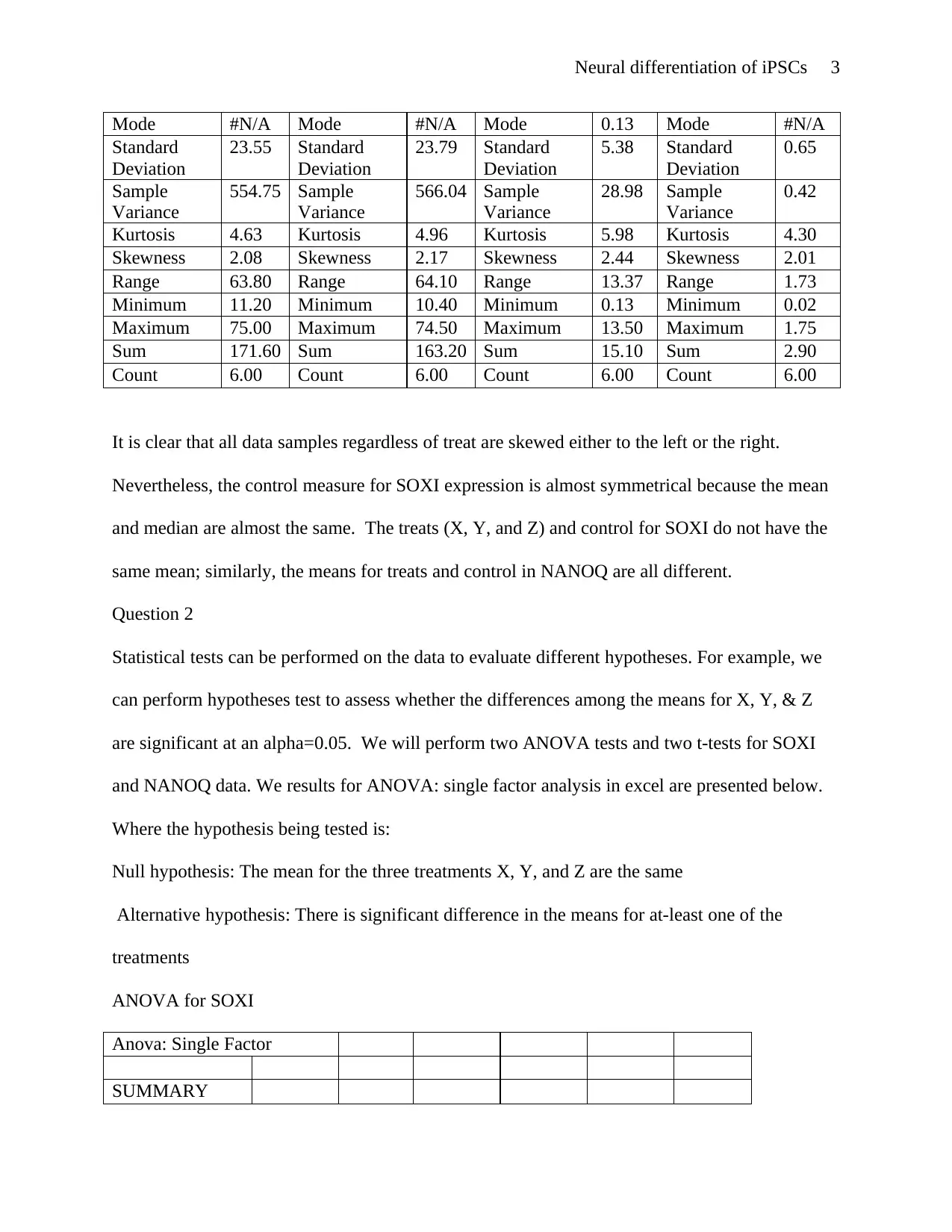
Neural differentiation of iPSCs 3
Mode #N/A Mode #N/A Mode 0.13 Mode #N/A
Standard
Deviation
23.55 Standard
Deviation
23.79 Standard
Deviation
5.38 Standard
Deviation
0.65
Sample
Variance
554.75 Sample
Variance
566.04 Sample
Variance
28.98 Sample
Variance
0.42
Kurtosis 4.63 Kurtosis 4.96 Kurtosis 5.98 Kurtosis 4.30
Skewness 2.08 Skewness 2.17 Skewness 2.44 Skewness 2.01
Range 63.80 Range 64.10 Range 13.37 Range 1.73
Minimum 11.20 Minimum 10.40 Minimum 0.13 Minimum 0.02
Maximum 75.00 Maximum 74.50 Maximum 13.50 Maximum 1.75
Sum 171.60 Sum 163.20 Sum 15.10 Sum 2.90
Count 6.00 Count 6.00 Count 6.00 Count 6.00
It is clear that all data samples regardless of treat are skewed either to the left or the right.
Nevertheless, the control measure for SOXI expression is almost symmetrical because the mean
and median are almost the same. The treats (X, Y, and Z) and control for SOXI do not have the
same mean; similarly, the means for treats and control in NANOQ are all different.
Question 2
Statistical tests can be performed on the data to evaluate different hypotheses. For example, we
can perform hypotheses test to assess whether the differences among the means for X, Y, & Z
are significant at an alpha=0.05. We will perform two ANOVA tests and two t-tests for SOXI
and NANOQ data. We results for ANOVA: single factor analysis in excel are presented below.
Where the hypothesis being tested is:
Null hypothesis: The mean for the three treatments X, Y, and Z are the same
Alternative hypothesis: There is significant difference in the means for at-least one of the
treatments
ANOVA for SOXI
Anova: Single Factor
SUMMARY
Mode #N/A Mode #N/A Mode 0.13 Mode #N/A
Standard
Deviation
23.55 Standard
Deviation
23.79 Standard
Deviation
5.38 Standard
Deviation
0.65
Sample
Variance
554.75 Sample
Variance
566.04 Sample
Variance
28.98 Sample
Variance
0.42
Kurtosis 4.63 Kurtosis 4.96 Kurtosis 5.98 Kurtosis 4.30
Skewness 2.08 Skewness 2.17 Skewness 2.44 Skewness 2.01
Range 63.80 Range 64.10 Range 13.37 Range 1.73
Minimum 11.20 Minimum 10.40 Minimum 0.13 Minimum 0.02
Maximum 75.00 Maximum 74.50 Maximum 13.50 Maximum 1.75
Sum 171.60 Sum 163.20 Sum 15.10 Sum 2.90
Count 6.00 Count 6.00 Count 6.00 Count 6.00
It is clear that all data samples regardless of treat are skewed either to the left or the right.
Nevertheless, the control measure for SOXI expression is almost symmetrical because the mean
and median are almost the same. The treats (X, Y, and Z) and control for SOXI do not have the
same mean; similarly, the means for treats and control in NANOQ are all different.
Question 2
Statistical tests can be performed on the data to evaluate different hypotheses. For example, we
can perform hypotheses test to assess whether the differences among the means for X, Y, & Z
are significant at an alpha=0.05. We will perform two ANOVA tests and two t-tests for SOXI
and NANOQ data. We results for ANOVA: single factor analysis in excel are presented below.
Where the hypothesis being tested is:
Null hypothesis: The mean for the three treatments X, Y, and Z are the same
Alternative hypothesis: There is significant difference in the means for at-least one of the
treatments
ANOVA for SOXI
Anova: Single Factor
SUMMARY
⊘ This is a preview!⊘
Do you want full access?
Subscribe today to unlock all pages.

Trusted by 1+ million students worldwide

Neural differentiation of iPSCs 4
Groups Count Sum Average Variance
X 6 79.7 13.28333 167.1697
Y 6 11.69 1.948333 8.171417
Z 6 102.6 17.1 291.784
ANOVA
Source of
Variation
SS df MS F P-value F crit
Between Groups 745.2443 2 372.6222 2.393077 0.12530
7
3.68232
Within Groups 2335.625 15 155.7084
Total 3080.87 17
Since, the F<F crit and the P-value is greater than alpha 0.05 we will not reject the null
hypothesis and state the means for the three treatments are similar.
ANOVA for NANOQ
Anova: Single
Factor
SUMMARY
Groups Count Sum Average Variance
X 6 163.2 27.2 566.036
Y 6 15.1 2.516667 28.98143
Z 6 2.9 0.483333 0.420147
ANOVA
Source of Variation SS df MS F P-value F crit
Between Groups 2654.363 2 1327.182 6.686755 0.00839
1
3.68232
Within Groups 2977.188 15 198.4792
Total 5631.551 17
In this case, the F>F crit and the P-value is less than alpha 0.05 we will reject the null hypothesis
and state the means for the three treatments are not similar for at-least one of the treatments.
Groups Count Sum Average Variance
X 6 79.7 13.28333 167.1697
Y 6 11.69 1.948333 8.171417
Z 6 102.6 17.1 291.784
ANOVA
Source of
Variation
SS df MS F P-value F crit
Between Groups 745.2443 2 372.6222 2.393077 0.12530
7
3.68232
Within Groups 2335.625 15 155.7084
Total 3080.87 17
Since, the F<F crit and the P-value is greater than alpha 0.05 we will not reject the null
hypothesis and state the means for the three treatments are similar.
ANOVA for NANOQ
Anova: Single
Factor
SUMMARY
Groups Count Sum Average Variance
X 6 163.2 27.2 566.036
Y 6 15.1 2.516667 28.98143
Z 6 2.9 0.483333 0.420147
ANOVA
Source of Variation SS df MS F P-value F crit
Between Groups 2654.363 2 1327.182 6.686755 0.00839
1
3.68232
Within Groups 2977.188 15 198.4792
Total 5631.551 17
In this case, the F>F crit and the P-value is less than alpha 0.05 we will reject the null hypothesis
and state the means for the three treatments are not similar for at-least one of the treatments.
Paraphrase This Document
Need a fresh take? Get an instant paraphrase of this document with our AI Paraphraser
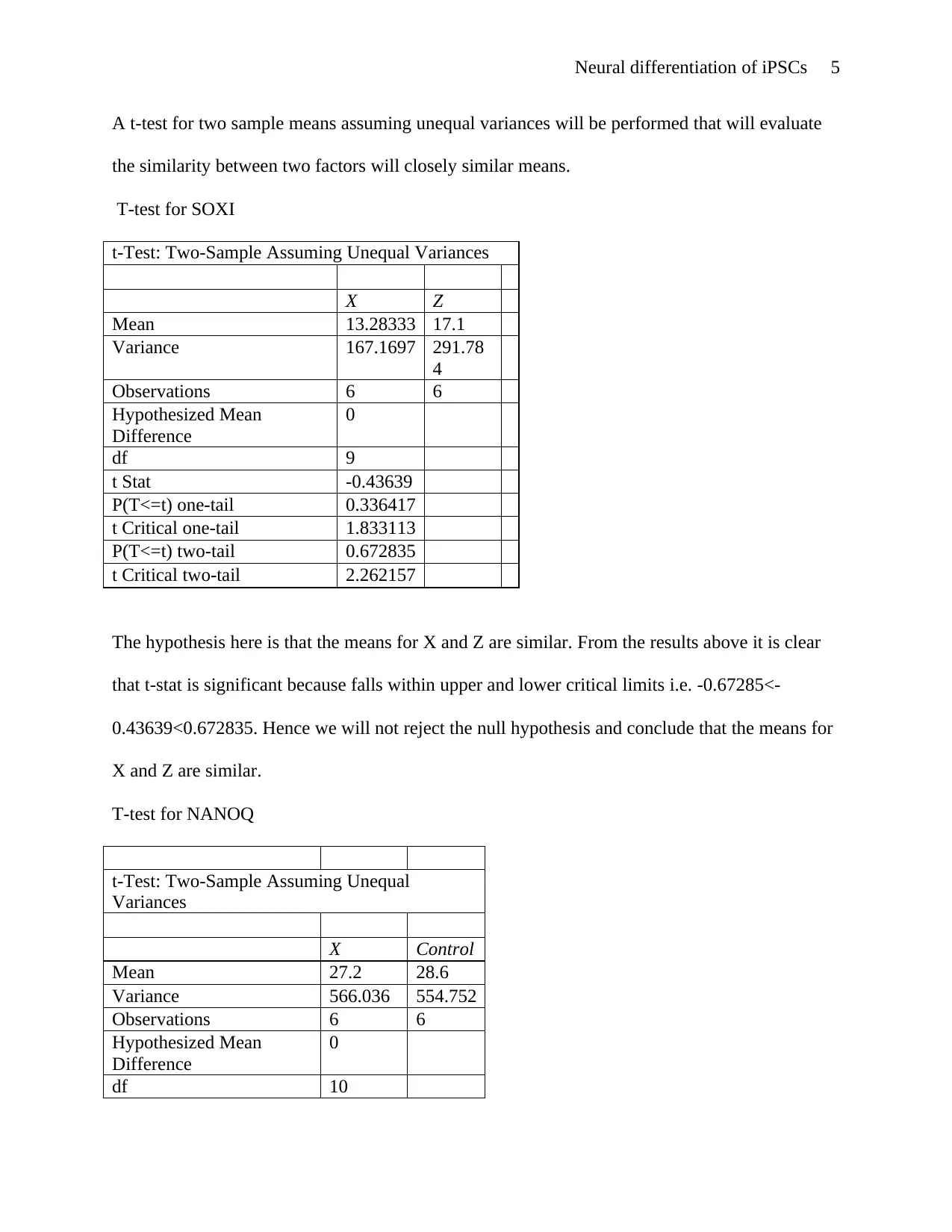
Neural differentiation of iPSCs 5
A t-test for two sample means assuming unequal variances will be performed that will evaluate
the similarity between two factors will closely similar means.
T-test for SOXI
t-Test: Two-Sample Assuming Unequal Variances
X Z
Mean 13.28333 17.1
Variance 167.1697 291.78
4
Observations 6 6
Hypothesized Mean
Difference
0
df 9
t Stat -0.43639
P(T<=t) one-tail 0.336417
t Critical one-tail 1.833113
P(T<=t) two-tail 0.672835
t Critical two-tail 2.262157
The hypothesis here is that the means for X and Z are similar. From the results above it is clear
that t-stat is significant because falls within upper and lower critical limits i.e. -0.67285<-
0.43639<0.672835. Hence we will not reject the null hypothesis and conclude that the means for
X and Z are similar.
T-test for NANOQ
t-Test: Two-Sample Assuming Unequal
Variances
X Control
Mean 27.2 28.6
Variance 566.036 554.752
Observations 6 6
Hypothesized Mean
Difference
0
df 10
A t-test for two sample means assuming unequal variances will be performed that will evaluate
the similarity between two factors will closely similar means.
T-test for SOXI
t-Test: Two-Sample Assuming Unequal Variances
X Z
Mean 13.28333 17.1
Variance 167.1697 291.78
4
Observations 6 6
Hypothesized Mean
Difference
0
df 9
t Stat -0.43639
P(T<=t) one-tail 0.336417
t Critical one-tail 1.833113
P(T<=t) two-tail 0.672835
t Critical two-tail 2.262157
The hypothesis here is that the means for X and Z are similar. From the results above it is clear
that t-stat is significant because falls within upper and lower critical limits i.e. -0.67285<-
0.43639<0.672835. Hence we will not reject the null hypothesis and conclude that the means for
X and Z are similar.
T-test for NANOQ
t-Test: Two-Sample Assuming Unequal
Variances
X Control
Mean 27.2 28.6
Variance 566.036 554.752
Observations 6 6
Hypothesized Mean
Difference
0
df 10
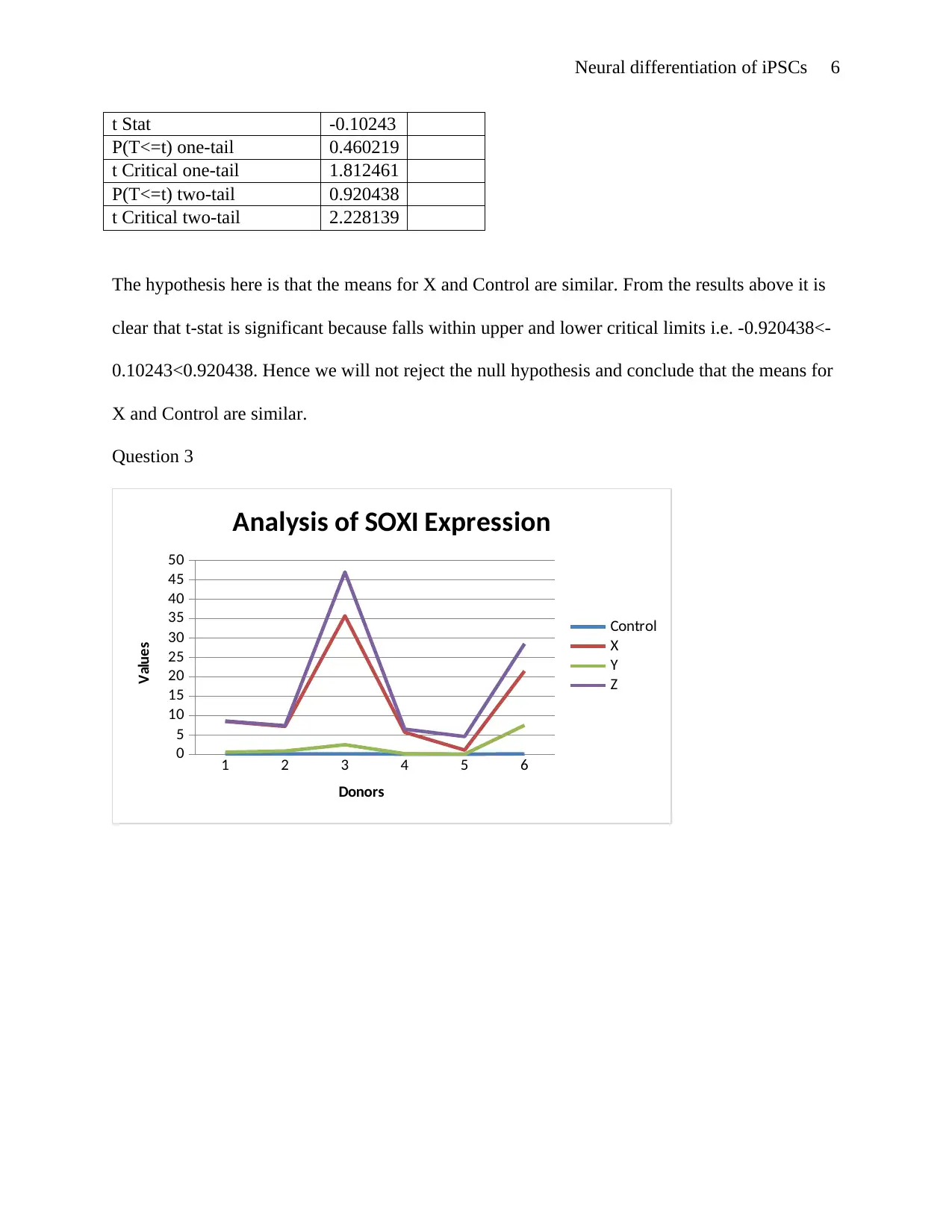
Neural differentiation of iPSCs 6
t Stat -0.10243
P(T<=t) one-tail 0.460219
t Critical one-tail 1.812461
P(T<=t) two-tail 0.920438
t Critical two-tail 2.228139
The hypothesis here is that the means for X and Control are similar. From the results above it is
clear that t-stat is significant because falls within upper and lower critical limits i.e. -0.920438<-
0.10243<0.920438. Hence we will not reject the null hypothesis and conclude that the means for
X and Control are similar.
Question 3
1 2 3 4 5 6
0
5
10
15
20
25
30
35
40
45
50
Analysis of SOXI Expression
Control
X
Y
Z
Donors
Values
t Stat -0.10243
P(T<=t) one-tail 0.460219
t Critical one-tail 1.812461
P(T<=t) two-tail 0.920438
t Critical two-tail 2.228139
The hypothesis here is that the means for X and Control are similar. From the results above it is
clear that t-stat is significant because falls within upper and lower critical limits i.e. -0.920438<-
0.10243<0.920438. Hence we will not reject the null hypothesis and conclude that the means for
X and Control are similar.
Question 3
1 2 3 4 5 6
0
5
10
15
20
25
30
35
40
45
50
Analysis of SOXI Expression
Control
X
Y
Z
Donors
Values
⊘ This is a preview!⊘
Do you want full access?
Subscribe today to unlock all pages.

Trusted by 1+ million students worldwide
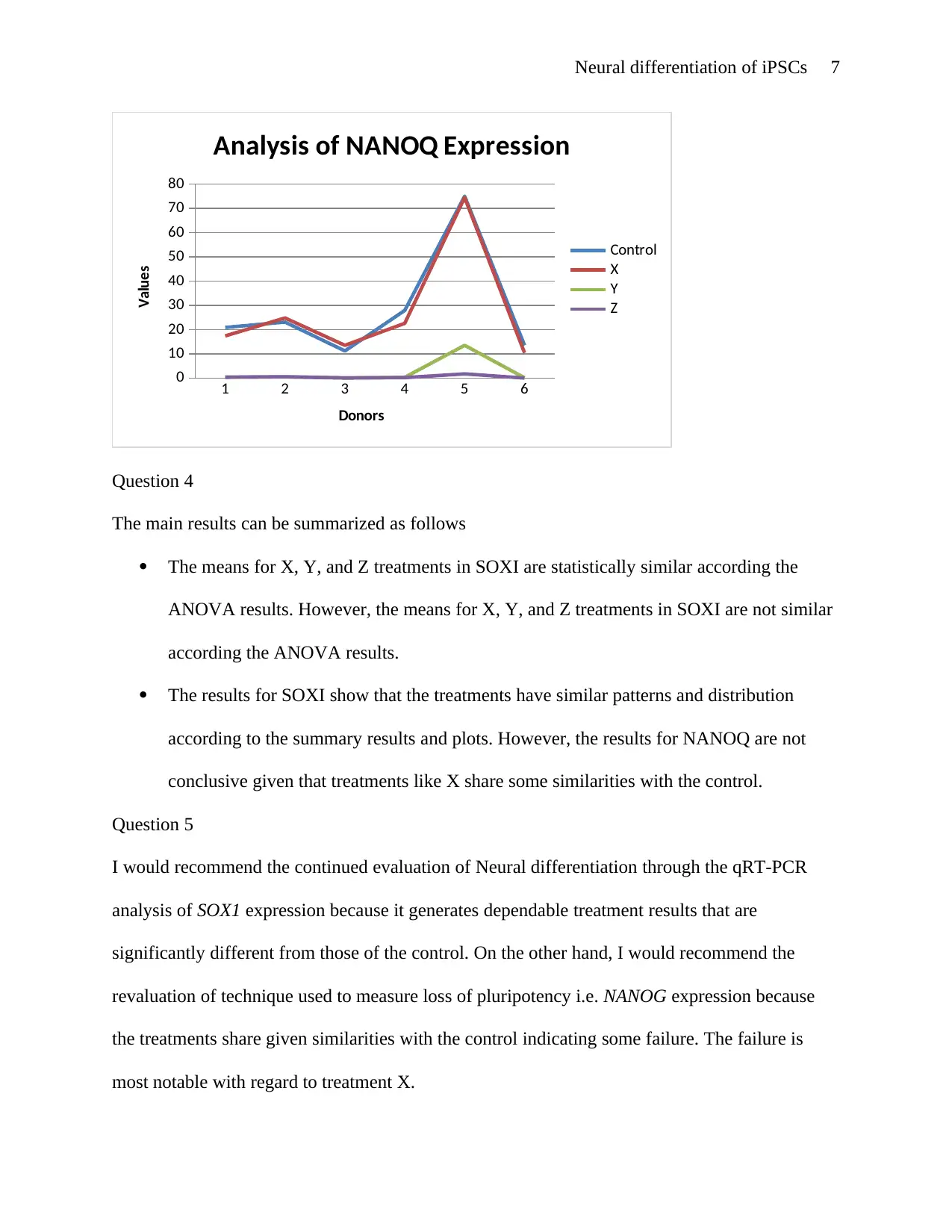
Neural differentiation of iPSCs 7
1 2 3 4 5 6
0
10
20
30
40
50
60
70
80
Analysis of NANOQ Expression
Control
X
Y
Z
Donors
Values
Question 4
The main results can be summarized as follows
The means for X, Y, and Z treatments in SOXI are statistically similar according the
ANOVA results. However, the means for X, Y, and Z treatments in SOXI are not similar
according the ANOVA results.
The results for SOXI show that the treatments have similar patterns and distribution
according to the summary results and plots. However, the results for NANOQ are not
conclusive given that treatments like X share some similarities with the control.
Question 5
I would recommend the continued evaluation of Neural differentiation through the qRT-PCR
analysis of SOX1 expression because it generates dependable treatment results that are
significantly different from those of the control. On the other hand, I would recommend the
revaluation of technique used to measure loss of pluripotency i.e. NANOG expression because
the treatments share given similarities with the control indicating some failure. The failure is
most notable with regard to treatment X.
1 2 3 4 5 6
0
10
20
30
40
50
60
70
80
Analysis of NANOQ Expression
Control
X
Y
Z
Donors
Values
Question 4
The main results can be summarized as follows
The means for X, Y, and Z treatments in SOXI are statistically similar according the
ANOVA results. However, the means for X, Y, and Z treatments in SOXI are not similar
according the ANOVA results.
The results for SOXI show that the treatments have similar patterns and distribution
according to the summary results and plots. However, the results for NANOQ are not
conclusive given that treatments like X share some similarities with the control.
Question 5
I would recommend the continued evaluation of Neural differentiation through the qRT-PCR
analysis of SOX1 expression because it generates dependable treatment results that are
significantly different from those of the control. On the other hand, I would recommend the
revaluation of technique used to measure loss of pluripotency i.e. NANOG expression because
the treatments share given similarities with the control indicating some failure. The failure is
most notable with regard to treatment X.
Paraphrase This Document
Need a fresh take? Get an instant paraphrase of this document with our AI Paraphraser

Neural differentiation of iPSCs 8
1 out of 8
Related Documents
Your All-in-One AI-Powered Toolkit for Academic Success.
+13062052269
info@desklib.com
Available 24*7 on WhatsApp / Email
![[object Object]](/_next/static/media/star-bottom.7253800d.svg)
Unlock your academic potential
Copyright © 2020–2025 A2Z Services. All Rights Reserved. Developed and managed by ZUCOL.





